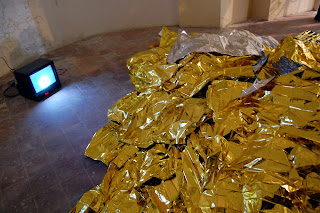[Scorri verso il basso per la versione in italiano]
AMAE - MYBODYISYOURBODYPROJECT - The OTHERSELVES Series, Act
1: Indelible
]Performance Space[
London, Hackney
Thursday 5th December 2013
(7 p.m. – 9 p.m.)
Act 1: Indelible
A new performance, open to anyone, but where any same sex
couple is invited to use a tattoo machine to inscribe an indelible mark on the
performer's skin. "This piece is beyond trust. It is more about care. AMAE
will offer its body to be used for the sharing of feelings.”
AMAE furthers its exploration of Queer Theory with a deeper
insight into the notion of care within performance art in relation to the
audience's body and the categorization of people in modern society.
“AMAE’s human skin is collecting something deeper than
simple touch. We are witnessing individual and collective feelings and we will
treasure them by wearing them on our skin. AMAE will share these inscribed
feelings with anyone who senses that something frightening is lurking in the
world in which we live.”
The OTHERSELVES series is an ongoing project in which the
body becomes a safe place, a sheltering tree, and a tablet written by all those
minorities who are often pushed to the edges of society.
/////////////////////////////////////////////////////////////////////////////////
AMAE - MYBODYISYOURBODYPROJECT - The OTHERSELVES Series, Act
1: Indelible
]Performance Space[
Londra, Hackney
Giovedì 5 dicembre (19:00 –
21:00)
Act 1: Indelebile Una nuova performance, aperta a tutti, ma dove ogni coppia dello stesso sesso è invitata ad usare una macchinetta per tatuaggi, al fine di lasciare un segno indelebile sulla pelle del performer. “Quest’opera va oltre la fiducia. Tratta principalmente di attenzione, considerazione, cura. AMAE offre il proprio corpo per la condivisione di sentimenti.”
AMAE continua ad indagare nell’esplorazione della Teoria
Queer attraverso una più profonda analisi interna alla nozione di
"considerazione" nell’ambito dell’arte performativa in relazione al
corpo del fruitore e alla categorizzazione nella società moderna.
“L’epidermide umana
di AMAE sta raccogliendo qualcosa di più intimo del semplice tocco. Siamo
testimoni di sentimenti individuali e collettivi e ne faremo tesoro
indossandoli sulla nostra pelle. AMAE condividerà
questi sentimenti inscritti con chiunque in grado di sentire
che qualcosa di spaventoso abita il mondo in cui viviamo.”
La serie OTHERSELVES (gli altri Sé) è un progetto in corso,
in cui il corpo diventa un luogo rifugio, un albero che protegge, una stele
scritta da tutte quelle minoranze che sono spesso spinte ai margini della
società.


.tif)



















.jpg)








.JPG)
.JPG)
.JPG)



















